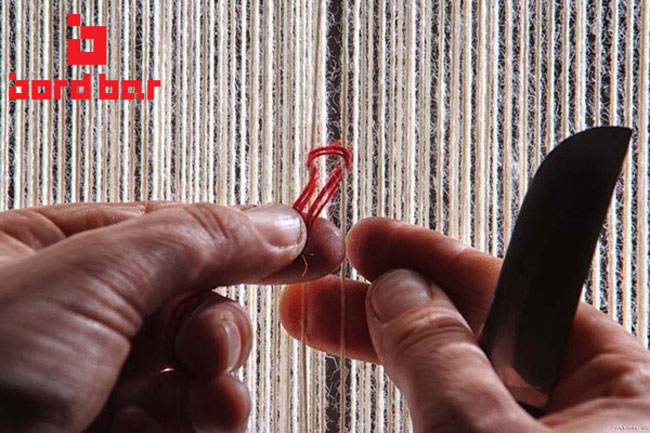Identifying the Type of Knot Used
To identify the type of knot used in any oriental rug, turn the rug over and examine the construction at the back. On the back of any hand- knotted rug, you can see thousands of tiny bumps or loops that are squarish in shape. These loops are the visible part of the knots as they go around the warp threads. If only two loops or bumps are visible across the warp at the place where the knot is tied, then the rug has been constructed using the Ghiordes knot. If there is only a single loop or bump visible, then you know it has been constructed using the Senneh knot. If the knot count is half or less than half of the warp count, then the rug is most likely constructed using the Jufti knot.
Persian & Oriental Knots – How Are Knot Counts Measured?
There are various measurements involved in the different areas when establishing how fine a rug is woven. The main measurement is KPSI (knots per square inch), similar to the pixels on a TV or computer screen the more pixel (or knots) the clearer and sharper the image. This is typically measured by counting the knots on the back of a rug across a vertical and horizontal inch and multiplying the two numbers. A 12×12 rug would have 144 KPSI. Note that the knotting in some rugs makes them look like they have twice as many knots horizontally than they actually have. There are however slightly different measurements used in certain areas: In certain areas of India, such as Bhadohi, Oriental rugs are measured using two numbers, for example: “5/40”, “9/60” or “13/65”. These numbers are called the bis and bhutan. The first number, or bis, is the number of knots in 9/10ths of an inch across the horizontal plane – so 9 would be 10 knots across (9/0.9=10). The second number, or bhutan, is the number of knots vertically in 4 1/2 inches. Therefore 60 bhutan is the equivalent of around 13 knots per vertical inch. A “9/60” rug would therefore be around 130 KPSI (10×13=130).
A quick method of calculating the Indian measurement is to multiply the two numbers and divide them by 4.05 (9×60=540… 540/4.05=133).
Chinese rugs use a measurement called line counts. This is typically described as “90 line” or “120 line” and refers to the number of knots (actually pairs of warps) measured in a linear foot of rug. In Chinese rug construction the number of knots vertically and horizontally are normally the same so a 120 line carpet has 100 KPSI (120/12=10… 10×10=100).
Rugs from Pakistan are normally described by the actual number of knots vertically and horzintally e.g. “16/16” or “16/18” which would equal 288 KSPI (16 × 18). These are called “double knot” which seems counter-logical. In Pakistan and in other countries you also get a “single knot” rug (such as in the 2nd picture above), to the unaware these seem to have a lot more knots in them than they actually have. The shape of the knots makes it look like there are two knots rather than one, you will notice on these rugs that there is never a colour (such as at the peak of a flower or triangle shape) which has what looks to be only one knot. There will always be two. These are measured in much the same way e.g. 9/16 which is 144 KPSI.
Even the Persian rugs have different measurements to denote the fineness of a carpet:
In Tabriz the term Raj is often used rather than KPSI – this is the number of knots across 2 3/4 inches of a rug. Typical measurements are “30 raj”, “35 raj”, “40 raj” or the super fine “60 raj”. A standard quality Tabriz at 35 raj would translate to around 162 KPSI (35/2.75=12.73… 12.73×12.73=162).
Nain rugsuse the term LAA, this does not directly translate to KPSI but is the number of yarn threads in an individual fringe at the end of a rug. The lower the LAA the higher quality the rug. Having a lower LAA means there can be more warp strings across the width of the carpet as each strand is finer which in turn allows more knots to be tied in a given area – since knots are tied around the warp string (which show as fringes at the top and bottom of a rug) then logic determines that the more warps in a rug mean equals more knots. To measure a fringe strand is unravelled which may contain 3 thin threads, one of these is unravelled again which could have another 3 threads (3×3) making it a 9 LAA rug called a Nola (nahola) in Farsi. A 6 LAA rug (3×2) is called a Shisla (shishla) and the finest rugs at 4 LAA (2×2) are Charla (sharla).
Isfahan rugs sometimes have different coloured threads between the fringe and the rug’s pile called kheft, this is measured across one metre and the number of different threads is an indication of quality.
Oriental Rug Knot Counting
Example of a Ghiordes knot

As mentioned earlier, rugs using the Ghiordes weave will have two bumps or loops across the warp on which the knot has been tied. It is important when counting knots to be sure to count the two bumps widthwise (on the horizontal axes) as a single knot, rather than two separate knots. A rug employing the Ghiordes knot with 10 knots in an inch along the horizontal axis and 20 knots in an inch along the vertical axis will have 200 knots per square inch. Amongst dealers, this rug might be referred to as a 10/20 (or 10×20) single knot rug. Others are illustrations of a Ghiordes rug with 11/22 knotting. In the image 1, the measuring tape has been laid out widthwise (on the horizontal axis) on the back of the rug employing the Ghiordes or symmetrical knot. The pens are pointing at two adjacent white bumps, which would appear to be two separate white knots. However, in reality these two bumps are part of the same knot, and the two bumps are counted as one knot on the horizontal axis. Similarly, the two red bumps on the left and right side of the white bumps also constitute one knot, as do the two black bumps on either side of the red bumps. In the Image 2, The notches marked on the measuring tape above indicate the knots along one inch of the horizontal axis. The first bump is counted and the second adjacent bump of the same color is skipped, as this is still part of the same knot, as illustrated in Image 1. Counting the knots from left to right the first two black bumps constitute one knot, the next two red bumps constitute the second knot, the two black bumps constitute the third knot, and so on. If you count carefully you will notice that there are 11 knots along the length of one inch on the horizontal axis. In image 3, Moving on to the vertical axis (or lengthwise), each bump constitutes one knot. The two pens above are pointing at two separate knots: one black knot and just below it, one white knot. In image 4, each pen is pointing to a white bump at the start and end of the inch. As each bump constitutes a knot on the vertical axis, each of the alternating colors constitute one knot each. Counting the alternating black and white bumps, the total comes to 22. The carpet shown in the images above therefore has a total of 242 knots per square inch (11/22 or 11×22), using the Ghiordes weave.
Example of a Senneh Knot

A rug employing the Senneh knot with 16 knots along an inch on the vertical axes and 16 knots along an inch on the horizontal axes has 256 knots per square inch. Amongst dealers, a rug with this knot formation may be referred to as a 16/16 double knot rug. See the illustrations for an example. In image 1, With rugs employing the Senneh knot, each bump constitutes one knot. The two pens in the image above illustrate this by pointing at two separate adjacent knots on the horizontal axis. In image 2, , the two pens point to the first knot and the last knot along the length of an inch on the horizontal axis (widthwise). In the image above, we count a total of sixteen knots within the tape-measure’s inch (this includes the two knots the pens are pointing at). In image 3, On the vertical axis (lengthwise to the rug), the two pens above point to the first knot and the last knot along the length of an inch. If you look carefully, you will be able to count 16 separate knots. Summary: The carpet thus has a total of 256 knots per square inch (16 × 16), using the Senneh weave.





